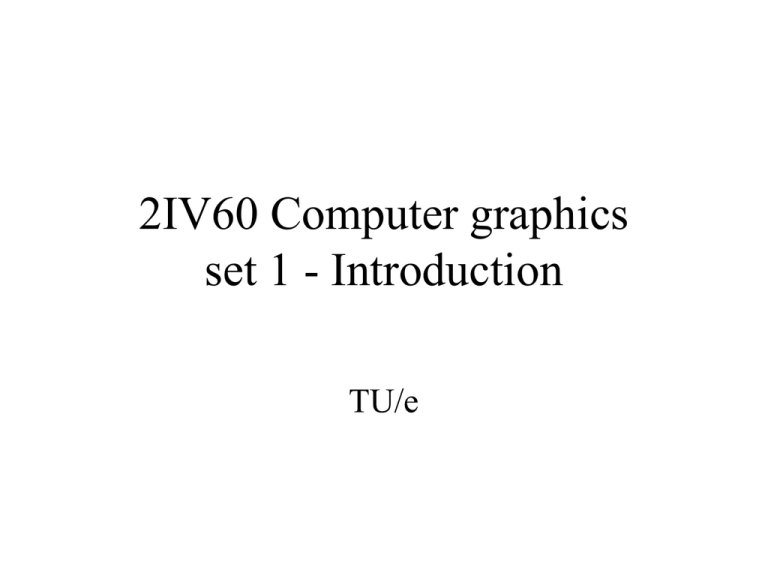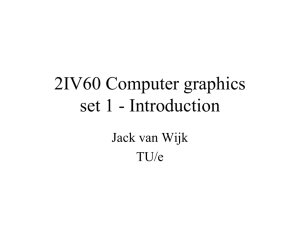
2IV60 Computer graphics
set 1 - Introduction
TU/e
2IV60 Computer graphics
• Aim:
Knowledge basic concepts 2D en 3D
computer graphics
• Lectures & instructions
• Assessment: Assignments and exam
Topics 2IV60
1.
2.
3.
4.
5.
6.
7.
Introduction
Basic math for graphics
Transformations
Viewing
Geometric modeling
Shading and illumination
Visible surfaces
2IV60
• 2IV60: started in 2012/13
• Based on 2IV10 Computergrafiek
• New:
–
–
–
–
First second year Bachelor
Halfway: test examination in week 5
Assignments: submission in week 3 and 7
Monday instructions: exercises
Thursday instructions: assignments
Lectures
16 lectures of two hours (max.)
•
•
•
•
•
Overview of material
Details (esp. algorithms, math.)
Elaboration home-work exercises
Questions!
Demo’s
Home-work exercises
•
•
•
•
•
•
Each week a new set
Voluntarily, but recommended
Check if things are understood
Explanation later in lecture
Preparation for exam (60%)
Grade for exam should be at least 5.0 to pass
Instructions
16 instructions (max.)
•
•
•
•
Instructors and student assistants
Home-work exercises (mondays)
Assignments (thursdays)
Questions!
Assignments
• Modeling and visualizing moving robots
Assignments
•
•
•
•
•
•
•
•
Modeling and visualizing moving robots
Java + OpenGL
Two rounds
Deadlines: after week 3 and 7:
1/12/2013, 12/1/2013.
To be done in pairs
Submit: source code via Peach
Judged: problem solved + explanation in comment
source code
40% of final result (14% first round, 26% second)
Intermediate exam
•
•
•
•
•
Check if course material has been understood
Individual
Two hours
December 15, during instruction hours
10% of final result
Course material
• Book:
– Donald Hearn, M. Pauline Baker, Warren
Carithers. Computer Graphics with OpenGL,
4th edition, Pearson Prentice Hall, paperback.
•
•
•
•
Study guide
Slides
Homework exercises and answers
Oase.tue.nl
Why computer graphics?
• Fun! Visible!
• Everywhere
• Visual system offers:
– Parallel input
– Parallel processing
• Computer graphics: ideal for humancomputer communication
Applications
• Graphs and charts
• Computer-Aided
Design
• Virtual Reality
• Data Visualization
• Education and training
•
•
•
•
Computer Art
Movies
Games
Graphical User
Interfaces
H&B 1:2-32
Business graphics
H&B 1:2-32
Computer-Aided Design
• AutoDesk
• IAME 2-stroke race kart engine
Data Visualization
Bruckner and Groeller,
TU Vienna, 2007
Holten, TU/e, 2007
H&B 1:2-32
Gaming
H&B 1:2-32
expression
depth of field
Movies
fracture
motion
water
reflection
hair
H&B 1:2-32
Hardware
• Fast development
• History: see book
• Now: Graphics Processing Unit (GPU),
LCD-screen
Beyond the laptop screen
• Microsoft Surface
• Apple iPad
Beyond the laptop screen
• 24 screen configuration, Virginia Tech
• Gigapixel display
• 50 LCD touchscreens
Beyond the laptop screen
Head mounted displays
Parachute trainer
US Navy
Beyond the laptop screen
• Roll-up screen, Philips
Schematic
Model
Display
interaction
User
Image
Also…
Computer
Graphics
Model
Image
Pattern
Recognition
Image
Processing
From model to image
Model
World
View
NDC
Display
Graphics pipeline
Coordinates and transformations
H&B 3-1:60-61
From model to image
Model
World
View
NDC
Display
Cylinder:
x2 y2 r 2
0 zh
Local or modeling coordinates
Geometric modeling
H&B 3-1:60-61
From model to image
Model
World
View
NDC
Display
Position cylinders in scene:
World coordinates
H&B 3-1:60-61
From model to image
Model
World
View
NDC
Display
Look at cylinders:
Viewing coordinates
Visible surfaces, shading
H&B 3-1:60-61
From model to image
Model
World
View
NDC
Display
Display:
1
0
Normalized Device Coordinates
1
H&B 3-1:60-61
From model to image
Model
World
View
NDC
Display
Display on screen:
0
1024
768
Device Coordinates
Interaction
H&B 3-1:60-61
Generating graphics
• Special-purpose programs
– Photoshop, Powerpoint, AutoCAD, StudioMax,
Maya, Blender, PovRay, …
• General graphics libraries and standards
– Windows API, OpenGL, Direct3D,…
H&B 3-2:61-62
CG standards
• Set of graphics functions, to be called from
programming language
• Access to and abstract from hardware
• Standardization
Fortran, Pascal, …
Display
Input dev.
C, C++, Java, Delphi,…
CG API
Drivers
Display
Input dev.
1975
2000
Functions
• Graphics Output Primitives
– Line, polygon, sphere, …
• Attributes
– Color, line width, texture, …
• Geometric transformations
– Modeling, Viewing
• Shading and illumination
• Input functions
H&B 3-2:61-62
Software standards
•
•
•
•
GKS, PHIGS, PHIGS+ (1980-)
GL (Graphics Library, SGI)
OpenGL (early 1990s)
Direct3D (MS), Java3D, VRML,…
H&B 3-3:62-63
OpenGL
•
•
•
•
•
•
•
3D (and 2D)
Fast
Hardware, language, OS, company independent
OpenGL architecture review board
Broad support
Low-level (right level!)
Standard graphics terminology
H&B 3-5:64-72
Intro OpenGL
•
•
•
•
Few basic principles
No questions asked at exam
Needed for assignments
Here: OpenGL 1.1
H&B 3-5:64-72
More info on OpenGL
• http://www.opengl.org,
http://www.opengl.org/sdk/docs/man2/
• The Red Book:
http://www.glprogramming.com/red/
• Many other web-sites
• No need to learn by head, aim at
being able to read manual pages
OpenGL, GLU and GLUT
• OpenGL: basic functions
• GLU: OpenGL Utility library:
• GLUT: OpenGL Utility Toolkit library
• GLU and GLUT:
– Handy functions for viewing and geometry
H&B 3-5:64-72
OpenGL and Java
• C: glFunction();
gluFunction(); glutFunction();
• Java: JOGL
gl.glFunction();
glu.gluFunction();
glut.glutFunction();
• No windowing functions offered by JOGL
• Assignment: skeleton offered
OpenGL syntax
• Functions:
glFunction: glBegin, glClear, glVertex, …
• Constants:
GL_CONSTANT: GL_2D, GL_LINE
• Datatypes:
GLtype: GLbyte, GLint, GLfloat
H&B 3-5:64-72
Example
glClearColor(1.0,1.0,1.0,0.0);// Background color
glMatrixMode(GL_PROJECTION); // Set transformation
glLoadIdentity;
gluOrtho2D(0, 200, 0, 150);
glClear(GL_COLOR_BUFFER_BIT); // Clear background
glColor3f(1.0, 0.0, 0.0);
glBegin(GL_LINES);
glVertex2i(180, 15);
glVertex2i(10, 145);
glEnd;
glFlush;
//
//
//
//
//
//
Set color to red
Draw line
- first point
- second point
Ready with line
Send
H&B 3-5:64-72
Example
Example 3D
•
•
•
•
Quick, minimal example
Lots of jargon and new material
Motivate studying theory
Enable quick start assignment
• Here: viewing and modeling transformations
H&B 3-5:64-72
Example 3D
Aim: Draw two rectangular boxes
1. Set up viewing transformation
2. Specify the colors
3. Draw the objects
Example 3D
// Set up viewing transformation
glViewport(0, 0, 500, 500);
// Select part of window
glMatrixMode(GL_PROJECTION); // Set projection
glLoadIdentity();
glFrustum(-1.0, 1.0, -1.0, 1.0, 4.0, 20.0);
glMatrixMode(GL_MODELVIEW);
glLoadIdentity();
gluLookAt(3.0, 6.0, 5.0,
1.0, 0.0, 0.0,
0.0, 0.0, 1.0);
// Set camera
- eye point
- center point
- up axis
Example 3D
// Clear background
glClearColor(1.0,1.0,1.0,0.0);// Background color
glClear(GL_COLOR_BUFFER_BIT); // Clear background
// Set color
glColor3f(0.0, 0.0, 0.0);
// Set color to black
Example 3D
// Draw two rectangular boxes
glutWireCube(1.0); // unit box around origin
glTranslatef(2.0, 0.0, 0.0); // move in x-direction
glRotatef(30, 0.0, 0.0, 1.0); // rotate 30 degrees
around z-axis
glScalef(1.0, 1.0, 2.0);
// scale in z-direction
glutWireCube(1.0); // translated, rotated, scaled box
Example 3D
glutWireCube(1.0); // unit box around origin
glTranslatef(3.0, 0.0, 0.0); // move in x-direction
glRotatef(30, 0.0, 0.0, 1.0); // rotate 30 degrees
around z-axis
glScalef(1.0, 1.0, 2.0);
// scale in z-direction
glutWireCube(1.0); // translated, rotated, scaled box
Note:
• Objects are drawn in the current local axis-frame;
• With transformations this frame can be changed.
Next
• Next lectures:
– Basic math
– 2D and 3D transformation
– 2D and 3D viewing












